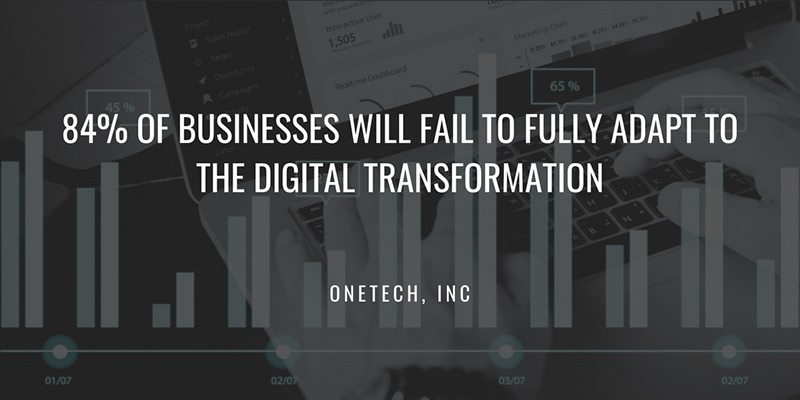
24 Jul 5 Ways of Digital Adaptation
It’s easy to uncover the best practices for becoming a digitally-integrated business in the modern world. Often, the average business interested in digital adaptation fails to optimize their efforts. In fact, anywhere up to the high extremities of 84% of businesses will fail to fully adapt to the digital transformation.
This isn’t to say that the growing IT field of connectivity is too complicated to be adopted. True, most business fail to adapt to any change – the nature of change seeks resistance. So what hopes does even the biggest conglomerate have? Now, we explore the top 5 ways that businesses successfully adapt to any digital element.
1. Becoming data-driven and analytical
When asked what some of the biggest influential factors for successful businesses were, most would answer either infrastructure or workforce. This, however, isn’t always the case. In fact, it is becoming less and less the ideal case especially in the example of an independent ride-services company: Uber.
Uber, relative to other large taxi companies, did not have the operational power or fleet agency that would signal it being the multi-billion venture that it is now. What Uber did have, however, is control of advanced analytics tools that yielded powerful insights on things like customer population, average fares, driver behavior, trip length, and everything else that is advantageous to running a successful ride-sharing empire.
In short, having contextual awareness over your industry’s demands and needs and integrating that with data mining techniques and advanced analytics can be greatly advantageous to expanding business growth.
2. Seek automation of simple and complex tasks
On the subject of automation, most companies by now have succeeded in automating simple tasks that usually consists of monotonous actions. The complications lie in attempted automation of more complex tasks that requires varying inputs. An example of such a task is making phone calls that requires collection of answers to changing queries.
Future automation of complex tasks including AI and machine learning could solve many business problems and free up valuable time for workers.
3. Gain connectivity to all things
In today’s work and home environment, connected devices are becoming commonplace. Depending on the industry, the value of being connected to your assets can be hugely profitable. With verticals such as fleet management, upstream oil and gas, or even agriculture, keeping track of where valuable commodities are can lead to optimization of asset management.
Managing connectivity to assets such as gas pipes or livestock does more than just tracking its location. Having a network of connected assets feeds big data to gain actionable insights that can enable predictive maintenance and other data-enabled optimization efforts.
4. User analytics
With the onset of IoT technology and connectivity, gaining insights into customer data is more crucial than ever before. This is especially potent to B2C industries due to the possibilities of acquiring data on KPIs such as browsing history, transactional orders, lifestyle decisions, etc. What businesses do with this information could influence business strategies for the better.
It may be surprising to some, but B2B companies can also benefit from these customer analytics. Knowledge into physical or digital assets that are sold to other businesses can give insight into how to optimize the assets or generate new supplementary assets.
5. Process Management
Managing different assets is vital especially to an industry like manufacturing. However, business process management can also be applied to all other industries that includes office work or field operations.
This form of process management can come in the form of wearables, connected apps, or smart devices. Real time alerts can be used to monitor strings of data analytics. Combining all the possibilities of IoT connectivity with utilization of historical data points can propel business operations to new heights!

